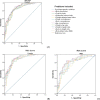Abdominal volume index, waist-to-height ratio, and waist circumference are optimal predictors of cardiometabolic abnormalities in a sample of Lebanese adults: A cross-sectional study
- PMID: 38127883
- PMCID: PMC10734963
- DOI: 10.1371/journal.pgph.0002726
Abdominal volume index, waist-to-height ratio, and waist circumference are optimal predictors of cardiometabolic abnormalities in a sample of Lebanese adults: A cross-sectional study
Abstract
The prevalence of cardiometabolic abnormalities is high globally. This is concerning since these abnormalities increase the risk of morbidity and mortality. Using noninvasive, low-cost, and ethnic-specific anthropometric indices is crucial for widespread screening and early detection of cardiometabolic abnormalities. In this cross-sectional study, we enrolled 221 Lebanese participants (62.9% females; mean age: 43.36 ± 16.05 years; mean body mass index (BMI): 28.43 ± 6.10 Kg/m2). The main outcome measure was cardiometabolic abnormality (CMA), defined as the presence of at least two or more non-anthropometric components of the Metabolic Syndrome. Several anthropometric indices: Total body fat percent, Conicity index, Abdominal volume index (AVI), Weight-adjusted-waist index, Waist circumference (WC), Neck circumference, Hip circumference, Waist-to-hip ratio, Waist-to-height ratio (WtHR), Neck-to-height ratio, and BMI were assessed in their prediction of CMA, using logistic regression modelling and c-statistic [95% confidence intervals (CIs)], and calibration plots, as well sensitivity, specificity, and negative and positive predictive values measures. The Benjamini-Hochberg correction procedure was used to correct for multiple testing. The prevalence of CMA was 52.0% (47.5% in females and 59.8% in males). Significant associations were found between all the anthropometric indices and CMA, except for neck-to-height ratio. AVI and WC were most predictive for CMA in the total sample. WtHR and WC were most predictive in females with suggested cut-off values of 0.58 and 91.25 cm, whereas AVI and WC were most predictive in males with suggested cut-off values of 19.61 and 101.50 cm. The neck-to-height measurement had the lowest predictive ability for CMA. Adding anthropometric indices to sociodemographic variables did not significantly improve model discrimination. AVI, WHtR, and WC best predicted CMA in a sample of Lebanese adults. These less invasive, low-cost, easy-to-measure indices can be used to screen widely for CMA to better manage and prevent disease and subsequent morbidity and mortality.
Copyright: © 2023 Abboud et al. This is an open access article distributed under the terms of the Creative Commons Attribution License, which permits unrestricted use, distribution, and reproduction in any medium, provided the original author and source are credited.
Conflict of interest statement
The authors have declared that no competing interests exist.
Figures


Similar articles
-
Assessment of the appropriate cutoff points for anthropometric indices and their relationship with cardio-metabolic indices to predict the risk of metabolic associated fatty liver disease.BMC Endocr Disord. 2024 Jun 4;24(1):79. doi: 10.1186/s12902-024-01615-3. BMC Endocr Disord. 2024. PMID: 38834991 Free PMC article.
-
Feasibility of body roundness index for identifying a clustering of cardiometabolic abnormalities compared to BMI, waist circumference and other anthropometric indices: the China Health and Nutrition Survey, 2008 to 2009.Medicine (Baltimore). 2016 Aug;95(34):e4642. doi: 10.1097/MD.0000000000004642. Medicine (Baltimore). 2016. PMID: 27559964 Free PMC article.
-
Comparative analysis of anthropometric indices of obesity as correlates and potential predictors of risk for hypertension and prehypertension in a population in Nigeria.Cardiovasc J Afr. 2017 Mar/Apr 23;28(2):92-99. doi: 10.5830/CVJA-2016-061. Epub 2016 Jul 13. Cardiovasc J Afr. 2017. PMID: 27701484 Free PMC article.
-
Association Between Anthropometric Indices and Nonanthropometric Components of Metabolic Syndrome in Saudi Adults.J Endocr Soc. 2022 Apr 4;6(6):bvac055. doi: 10.1210/jendso/bvac055. eCollection 2022 Jun 1. J Endocr Soc. 2022. PMID: 35592514 Free PMC article.
-
Determining the best method for evaluating obesity and the risk for non-communicable diseases in women of childbearing age by measuring the body mass index, waist circumference, waist-to-hip ratio, waist-to-height ratio, A Body Shape Index, and hip index.Nutrition. 2023 Oct;114:112135. doi: 10.1016/j.nut.2023.112135. Epub 2023 Jun 16. Nutrition. 2023. PMID: 37453224
Cited by
-
The association of lipid accumulation product with inflammatory parameters and mortality: evidence from a large population-based study.Front Epidemiol. 2025 Feb 4;4:1503261. doi: 10.3389/fepid.2024.1503261. eCollection 2024. Front Epidemiol. 2025. PMID: 39967714 Free PMC article.
-
Abdominal volume index is associated with higher oxidized LDL, high blood pressure and lower HDL among obese adults.BMC Endocr Disord. 2025 Feb 28;25(1):56. doi: 10.1186/s12902-025-01884-6. BMC Endocr Disord. 2025. PMID: 40016702 Free PMC article.
-
Association Between Osteoporosis and Adiposity Index Reveals Nonlinearity Among Postmenopausal Women and Linearity Among Men Aged over 50 Years.J Epidemiol Glob Health. 2024 Sep;14(3):1202-1218. doi: 10.1007/s44197-024-00275-9. Epub 2024 Jul 24. J Epidemiol Glob Health. 2024. PMID: 39046667 Free PMC article.
-
Association between weight-adjusted waist index and hepatic steatosis and fibrosis: Analyses of the NHANES 2017 to 2020.Medicine (Baltimore). 2025 Jun 6;104(23):e42708. doi: 10.1097/MD.0000000000042708. Medicine (Baltimore). 2025. PMID: 40489808 Free PMC article.
-
Bridging the gap in obesity research: A consensus statement from the European Society for Clinical Investigation.Eur J Clin Invest. 2025 Aug;55(8):e70059. doi: 10.1111/eci.70059. Epub 2025 May 15. Eur J Clin Invest. 2025. PMID: 40371883 Free PMC article. Review.
References
-
- Alberti KG, Eckel RH, Grundy SM, Zimmet PZ, Cleeman JI, Donato KA, et al.. Harmonizing the metabolic syndrome: a joint interim statement of the International Diabetes Federation Task Force on Epidemiology and Prevention; National Heart, Lung, and Blood Institute; American Heart Association; World Heart Federation; International Atherosclerosis Society; and International Association for the Study of Obesity. Circulation. 2009;120(16):1640–5. doi: 10.1161/CIRCULATIONAHA.109.192644 - DOI - PubMed
-
- O’Neill S O’Driscoll L. Metabolic syndrome: a closer look at the growing epidemic and its associated pathologies. Obesity Reviews. 2015;16(1):1–12. - PubMed
-
- Bahijri SM, Al Raddadi RM, Jambi H, Alaama M-NA, Ferns G. The prevalence of metabolic syndrome in an apparently healthy, normotensive and non-diabetic population in Saudi Arabia by two definitions: implications for local practice. Journal of Endocrine and Metabolic Diseases. 2013;3:18–24.
LinkOut - more resources
Full Text Sources
